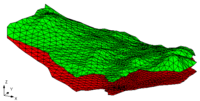GMS:Building Solids and 3D Meshes with TINs: Difference between revisions
From XMS Wiki
Jump to navigationJump to search
No edit summary |
No edit summary |
||
| Line 4: | Line 4: | ||
*[[GMS:Horizons to Solids|'''Horizons -> Solids''']] | *[[GMS:Horizons to Solids|'''Horizons -> Solids''']] | ||
*[[GMS:Horizons to 3D Mesh|'''Horizons -> 3D Mesh''']] | *[[GMS:Horizons to 3D Mesh|'''Horizons -> 3D Mesh''']] | ||
*'''Fill Between TINs -> 3D Mesh''' See [[GMS:Creating_a_3D_Mesh#Fill_Between_TINs_-.3E_3D_Mesh|Creating a 3D Mesh]] | |||
[[ | |||
'''The preferred method for creating solids is the Horizons method.''' | '''The preferred method for creating solids is the Horizons method.''' | ||
*'''Extrude TIN -> Solid''' - This command creates a new solid from each of the selected TINs by extruding each of the TINs up or down to an elevation specified by the user. Extruded TINs are useful in the construction of solid models of soil stratigraphy. | *'''Extrude TIN -> Solid''' - This command creates a new solid from each of the selected TINs by extruding each of the TINs up or down to an elevation specified by the user. Extruded TINs are useful in the construction of solid models of soil stratigraphy. | ||
*'''Fill Between TINs -> Solid''' - This command provides a quick way to create a solid bounded above and below by two or more selected TINs. The TIN defining the top of the boundary of the solid should be selected first. The remaining TIN(s) are then selected. All selected TINs are extruded down to an arbitrary elevation below that of all the selected TINs. GMS then performs a difference set operation . | *'''Fill Between TINs -> Solid''' - This command provides a quick way to create a solid bounded above and below by two or more selected TINs. The TIN defining the top of the boundary of the solid should be selected first. The remaining TIN(s) are then selected. All selected TINs are extruded down to an arbitrary elevation below that of all the selected TINs. GMS then performs a difference set operation. | ||
TINs can be used to build three-dimensional solid models of the soil layers. The transformation from TINs to solids is accomplished using a TIN extrusion and [[GMS:Set Operations|set operation]] procedure illustrated in two dimensions in the following figure. A two-dimensional cross section of three TINs, labeled p, q, and r, is shown in part (a). | |||
''The TIN Extrusion and Set Operation Process. (a) Sample TINs. (b) Extrusion of Surfaces Into Solids. (c) Creation of Layers Through Set Operations. (d) Completed Solid Model of Soil Stratigraphy.'' | {{only in print|[[Image:stratigmod.gif|frame|right|''The TIN Extrusion and Set Operation Process. (a) Sample TINs. (b) Extrusion of Surfaces Into Solids. (c) Creation of Layers Through Set Operations. (d) Completed Solid Model of Soil Stratigraphy.'']]}} | ||
}} | |||
{{hide in print|[[Image:stratigmod.gif|''The TIN Extrusion and Set Operation Process. (a) Sample TINs. (b) Extrusion of Surfaces Into Solids. (c) Creation of Layers Through Set Operations. (d) Completed Solid Model of Soil Stratigraphy.'']]}} | |||
The TINs are converted into temporary solid primitives that represent approximations of the soil layers. The conversion is accomplished by projecting the outer boundary (perimeter) of each TIN down to a horizontal plane. This can be thought of as an extrusion process where a two-dimensional surface is extruded into a three-dimensional solid. A three-dimensional illustration of this process is shown in the figure below. | The TINs are converted into temporary solid primitives that represent approximations of the soil layers. The conversion is accomplished by projecting the outer boundary (perimeter) of each TIN down to a horizontal plane. This can be thought of as an extrusion process where a two-dimensional surface is extruded into a three-dimensional solid. A three-dimensional illustration of this process is shown in the figure below. | ||
| Line 28: | Line 26: | ||
The combination of [[GMS:TIN Module#Editing a TIN|TIN editing]], TIN extrusion, and [[GMS:Set Operations|set operations]] represents a powerful and flexible tool that makes it possible to model complex stratigraphic relationships such as truncations, faults, embedded seams, and pinchout zones. Once the models are constructed, the volumes of the solids can be viewed using the Get Info command in the File menu. In addition, the models can be further modified using set operations to simulate complex excavations. Cross sections and fence diagrams can be constructed from the solid models at any location and at any orientation. | The combination of [[GMS:TIN Module#Editing a TIN|TIN editing]], TIN extrusion, and [[GMS:Set Operations|set operations]] represents a powerful and flexible tool that makes it possible to model complex stratigraphic relationships such as truncations, faults, embedded seams, and pinchout zones. Once the models are constructed, the volumes of the solids can be viewed using the Get Info command in the File menu. In addition, the models can be further modified using set operations to simulate complex excavations. Cross sections and fence diagrams can be constructed from the solid models at any location and at any orientation. | ||
See also [[GMS:Solid Module|Solid Module]]; [[GMS:3D Mesh Module#Creating a 3D Mesh|3D mesh generation]] | See also [[GMS:Solid Module|Solid Module]]; [[GMS:3D Mesh Module#Creating a 3D Mesh|3D mesh generation]] | ||
